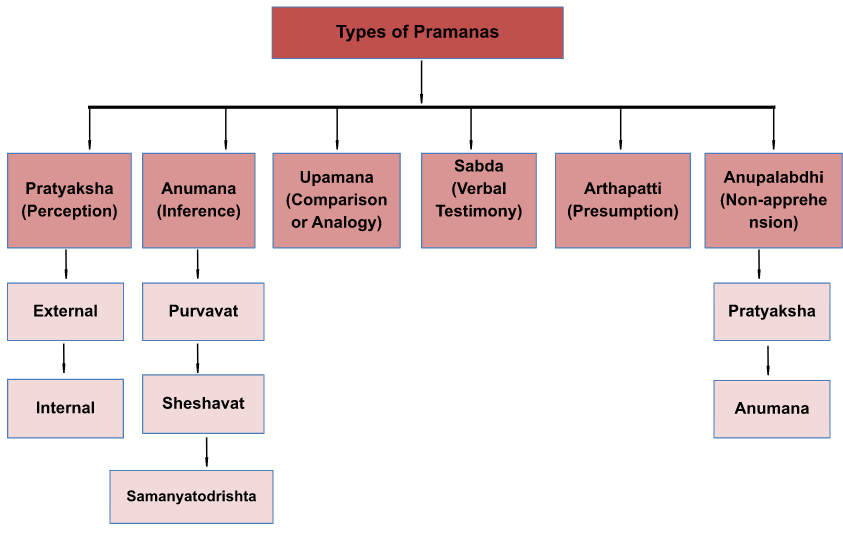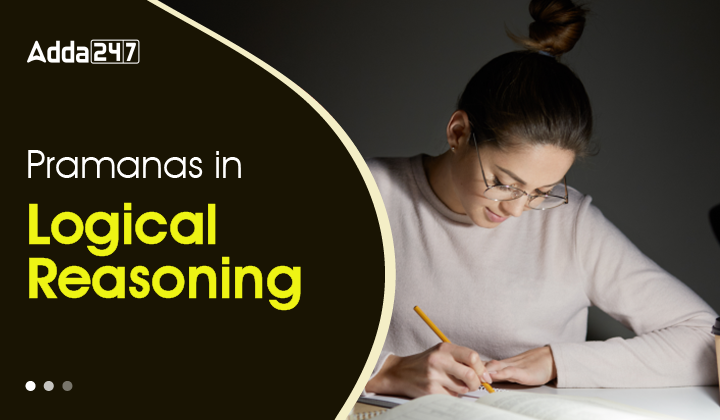Table of Contents
Pramanas are a key concept in Indian philosophy, and they play an important role in the practice of logical reasoning. In this context, pramanas can be understood as the means or methods by which we acquire knowledge and justify our beliefs. They are used to determine the truth or falsity of a given proposition and to establish the validity of knowledge claims.
UGC NET Study Notes for Paper 1
Features of Pramanas
Some important features of pramanas are:
- The pramanas are not only relevant in philosophy and logic but also have practical applications in everyday life.
- For instance, we rely on perception to navigate the world around us, inference to make predictions and decisions, testimony to gain information from others, and presumption to make assumptions.
- By understanding the pramanas and their limitations, we can make more informed decisions and avoid common errors in reasoning.
Pramanas Types

Pratyaksha (Perception)
- Pratyaksha is direct perception or sensory experience.
- It is the most fundamental pramana, as it is the basis for all other forms of knowledge.
- We acquire knowledge of the external world through our sense organs, such as the eyes, ears, nose, tongue, and skin.
| Types of Pratyaksha | |
|---|---|
| External perception | It is the direct apprehension of objects in the external world through our sense organs. For example, seeing a tree, hearing a bird’s song, smelling a flower, etc. |
| Internal perception | It is the direct apprehension of mental states, such as thoughts, emotions, and desires. For example, feeling happy, experiencing fear, etc. |
Anumana (Inference)
- Anumana is indirect knowledge acquired through inference.
- It is based on the observation of a particular phenomenon and the subsequent application of a general principle to explain it.
- For example, if we observe smoke rising from a distant hill, we infer that there is a fire, based on the general principle that smoke is produced by fire.
Anumana (Inference) is of three types which are as following:
| Three types of Inference | |
|---|---|
| Purvavat (prior knowledge) |
Purvavat inference is when we infer the existence of a cause from the effect. |
| Sheshavat (posterior knowledge) |
Sheshavat inference is when we infer the existence of an effect from the cause. |
| Samanyatodrishta (universal knowledge) | Samanyatodrishta inference is when we infer a universal principle from particular instances. |
Anumana (Inference) has three elements which are as follows:
| Three elements of Anumana | |
| The Hetu (reason) | The Hetu is the reason or the ground on which the inference is made |
| The sadhya (proposition) | The Sadhya is the proposition that is inferred. |
| The Paksha (subject) | The Paksha is the subject or the locus of inference. |
Upamana (Comparison or Analogy)
- Upamana is knowledge acquired through comparison or analogy.
- It involves the comparison of two or more things based on their similarity in certain respects.
- For example, if someone asks for the location of a new restaurant in town, we might say “It’s in the same building as the post office.” Here, the analogy is based on the similarity of the location of the two buildings.
| Three elements of Upamana | |
|---|---|
| 1 | The Upameya (the object being compared) |
| 2 | The Upama (the object of comparison) |
| 3 | The Samanya (the common attribute) |
Sabda (Verbal Testimony)
- Sabda is knowledge acquired through verbal testimony or the word of authority.
- It is based on the assumption that there are certain individuals who possess knowledge that is beyond the reach of ordinary individuals.
- These individuals are known as sabda-pramanas or verbal authorities.
| Two elements of Sabda | |
|---|---|
| 1 | The Sabda-pramana (verbal authority) |
| 2 | The Sabda (the statement) |
Arthapatti (Presumption)
- Arthapatti is knowledge acquired through presumption.
- It involves the acceptance of a proposition as true based on the presumption that the absence of the proposition would lead to a contradiction.
- For example, if we see a man eating food without any visible signs of hunger, we may presume that he is fasting.
| Two elements of Arthapatti | |
|---|---|
| 1 | The Pradhana (the principal subject) |
| 2 | The Pratijna (the proposition) |
Anupalabdhi (Non-apprehension)
- Anupalabdhi is often translated as non-apprehension or absence.
- It involves knowing something by recognizing the absence of it.
- For example, we might know that there is no milk in the refrigerator by opening the door and seeing that there is no milk.
| Types of Anupalabdhi | |
|---|---|
| Pratyaksha-Anupalabdhi (direct non-apprehension) |
Pratyaksha-Anupalabdhi is when we directly perceive the non-existence of something. For example, when we look for a pen in a room and do not find it, we gain knowledge of its non-existence. |
| Anumana-Anupalabdhi (inferential non-apprehension) | Anumana-Anupalabdhi is when we infer the non-existence of something based on its absence. For example, if we see a person who has never eaten spicy food before not showing any signs of discomfort after eating a spicy dish, we can infer that they do not find it spicy. |
In conclusion, pramanas are a crucial aspect of Indian philosophy and logic, particularly in the context of epistemology and knowledge acquisition. The six pramanas provide a framework for understanding the various sources of knowledge and their reliability, enabling individuals to distinguish between true and false beliefs. By examining each pramana in detail, we have seen how perception, inference, comparison, testimony, presumption, and non-apprehension can be used to establish valid knowledge.
Download Pramanas Study Notes of logical reasoning PDF
| UGC NET Important Links | |
| UGC NET 2023 Notification | UGC NET New Syllabus |
| UGC NET Previous Year Papers | UGC NET Teacher Salary |




 What is Soil Pollution - Causes, Effects...
What is Soil Pollution - Causes, Effects...
 UGC NET Philosophy Syllabus 2025 PDF Dow...
UGC NET Philosophy Syllabus 2025 PDF Dow...
 UGC NET Commerce Syllabus 2025 PDF Downl...
UGC NET Commerce Syllabus 2025 PDF Downl...












